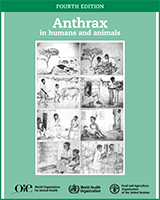All rights reserved. Publications of the World Health Organization can be obtained from WHO Press, World Health Organization, 20 Avenue Appia, 1211 Geneva 27, Switzerland (tel.: +41 22 791 3264; fax: +41 22 791 4857; e-mail: tni.ohw@sredrokoob). Requests for permission to reproduce or translate WHO publications – whether for sale or for noncommercial distribution – should be addressed to WHO Press, at the above address (fax: +41 22 791 4806; e-mail: tni.ohw@snoissimrep).
NCBI Bookshelf. A service of the National Library of Medicine, National Institutes of Health.
Anthrax in Humans and Animals. 4th edition. Geneva: World Health Organization; 2008.
1.1. The natural disease
Anthrax is primarily a disease of herbivores although few, if any, warm-blooded species are entirely immune to it. According to Sterne (1959), amphibians and reptiles are naturally resistant but warming of cold-blooded animals allows them to be experimentally infected. From the earliest historical records until the development of an effective veterinary vaccine midway through the present century (Sterne, 1937b; Sterne et al., 1939), and the subsequent advent of antibiotics, the disease was one of the main causes of uncontrolled mortality in cattle, sheep, goats, horses and pigs worldwide. Reports of the World Organisation for Animal Health (OIE)1 show that the disease is still enzootic in most countries of Africa and Asia, a number of European countries and countries/areas of North and South America; it still occurs sporadically in many other countries.
1.2. Deliberate release – bioaggression
Bacillus anthracis has always been high on the list of potential agents with respect to biological warfare and bioterrorism (Klietmann & Ruoff, 2001; see also section 3.3.10) and as is well known, it has now been used in that context in the anthrax letter events in 2001 in the USA with severe consequences (Jernigan et al., 2001; Inglesby et al., 2002).2 This, unfortunately, has attached an unjustified doomsday image to the naturally-occurring disease. It is important however to clearly distinguish the natural and deliberate release situations: the massive exposures that can be created in man-made deliberate release scenarios cannot be remotely emulated by nature. The natural disease is readily controllable in contrast to the biowarfare/bioterrorist act (see also section 4.2.3).
Footnotes
- 1
OIE World Animal Health Information Database (WAHID) Interface: http://www
.oie.int/wahid-prod/public .php?page=home. - 2
Please refer also to Emerging Infectious Diseases. 2002;8(10) [PMC free article: PMC2730302] [PubMed: 12396908].
- The disease and its importance - Anthrax in Humans and AnimalsThe disease and its importance - Anthrax in Humans and Animals
Your browsing activity is empty.
Activity recording is turned off.
See more...
